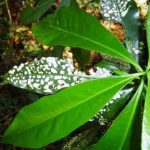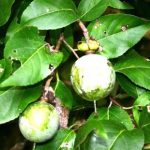TREE LIFE
August 2006
Please note that with immediate effect the post office box number for the Tree Society has changed to:
P.O. BOX A 273 AVONDALE HARARE
MASHONALAND CALENDAR
Saturday 5th August: Tom will lead the walk in the Botanic Gardens on Saturday at 11 am.
August 12th-15th: Heroes Weekend. We shall be visiting the ‘dry side’ of Nyanga in the Brondesbury Park area. Numbers are limited. Please contact Mark if you are interested.
Sunday 20th August: Visit to Ewanrigg, where we hope to have a look at native and exotic trees and also the flowering Aloes.
Ewanrigg is run by National Parks and there will be entrance fees. Currently, we understand the entry fee is Z$345 000 per person with an additional charge for the vehicle of Z$115 000. We will meet at 9.30 am. Allow about ¾ hour travelling time.
Saturday 26th August: By kind permission of Mrs. Van der Merwe and her son, we will be visiting Price’s Brickfields in Avondale. This is a new area for us; I understand that trees may be a bit limited, in which case we will look at the herbaceous and aquatic species.
MATABELELAND CALENDAR
Please contact Jean Wiley or Gill Short for details of the next Matabeleland function.
VERNACULAR NAMES LIST
The late Lyn Mullin at the time of his death in 2003 had just completed compiling a list of vernacular names of Zimbabwean plants.
We have recently heard from publisher Ian Murphy that finance has been obtained to enable this to be published.
The Dutch embassy have agreed to finance the production of 1500 copies. Their only requirement is that they receive 50 copies themselves. The remainder (1450) will be for us to sell for Tree Society funds if we wish.
Ian is aiming for something similar in size and style to Jonathan Timberlake’s Acacia book. I have asked him to go ahead with his own designs. We will be given a mock-up of the product before it goes to be printed for us to make comments on. Ian told me that the book will be printed in Singapore and will be ‘of the highest quality’.
Our thanks must really go to Ian, as he has managed to make it happen.
Mark Hyde
Dear members,
This month we very sadly had to report the untimely and tragic death of one of our members, Barbara Scheidler, in a “wild life” accident in Mana Pools.
For the benefit of all those who have known Barbara and also for the purpose of countering the numerous variations of rumours which have begun to sprout around the circumstances leading to Barbara’s death, we include below a summarised excerpt of the official report by Norman Monks, Senior Warden (Scientific and Operations), Mana Pools National Park.
“DEATH OF TOURIST BY ELEPHANT
… on 11th July 2006, at about 16:00hrs, a tourist was killed by elephant near Ndungu Camp on the Zambezi. This tourist, Barbara Scheidler, was a German national but with Zimbabwe resident status… The circumstances leading to this unfortunate incident near ” Ndungu campsite is on the Zambezi River about 12 kilometres upstream of Nyamepi Headquarters. The victim was with her cousin Michael Doenhoff and his girlfriend, but had gone for a walk on her own to take some pictures and it appears that she was walking at the base of the high river bank down to the river sand, below the “Parking Area” near Ndungu.
Due to the findings on the body by Dr. Murphree, Mr. Monks’ wife, it is believed that she came across the elephant by accident as they were coming down the bank path on their way to the water.
The elephant is thought to have been a tuskless cow (cows with young had been seen in the area) and all indications point to a “quick attack”, resulting in Ms. Scheidler’s neck being broken and hardly any other trauma inflicted…….
We are still very shocked about her tragic death and our sympathy goes to her family, friends and colleagues.
VUMBA SPECIAL This is the third article in an occasional, more lighthearted series about trees in the Vumba, written by our member Bart Wursten.
September is the month of the fires. Everywhere in the country the grasslands and woodlands are burning. Some are caused by accident, many on purpose and most out of sheer neglect. Most years the Vumba is not spared and areas such as Chinyakwaremba, often erroneously called Leopard Rock, are burnt. Is this a disaster? Not really. Just then, you might not want to go for a scenic hike to enjoy the spectacular views into Mozambique, but there won’t be much to view during these hazy months anyway. Give it a few weeks and the grasses and flowers will start to poke their heads above the ashes; give it a few months and the mountain will look better and healthier than before the fires.
Fires are nothing new. Long before man came and started his destructive manipulation of nature, fires raged through these same grasslands and woodlands, during the same months of the year. The trees of these habitats have evolved to withstand these circumstances with thicker and more fire-resistant bark; plants and grasses have “learned” to store their reserves underground, where they are safe from cold, drought and fire. For some plants, called pyrophytes, the fires actually are a wake-up call: “Winter is over! Time to party!” It is an encouragement for these plants to flower and for seeds to germinate.
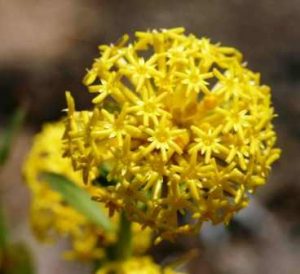
Gnidia kraussiana. Photo: Petra Ballings. Source: Flora of Zimbabwe
Just look along the roadsides in September, a few weeks after flames scorched the earth, and you will find a wonderful mosaic of colours: bright yellow balls of Gnidia kraussiana dot the blackened landscape. They might be surrounded by shocking pink patches of Indigofera hilaris or small cushions of Pentanisia schweinfurthii flashing a most unlikely blue.
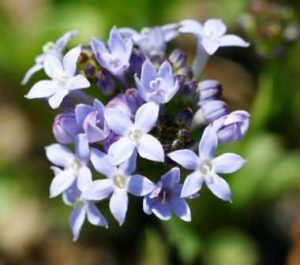
Pentanisia schweinfurthii. Photo: Petra Ballings. Source: Flora of Zimbabwe
These are just some of the many plants, which seem to have been waiting for this very moment to stick their handsome heads through the soil.
Not all plants are adapted to withstand fires. Some, like the trees and plants in our Vumba forests, are used to living in a moist environment, which does not normally get exposed to fires. Others choose their homes on cliffs, among boulders or on the higher branches of trees, where they can usually stay out of reach of the heat and the flames. It is in these situations where the ‘know-no-limits’ attitudes of man can cause serious problems for nature. Too much of a good thing can’t be good and too many fires too many times will also cause damage. Maybe fire is to plants what alcohol is to people. Not too much not too often and you’ll be fine.
Check out www.zimbabweflora.co.zw to have a look at these and many other colourful flowers or come and stay at Ndundu Lodge in Vumba where spectacular views are just one of many attractions.
Footnote: Bart and Petra recently returned from S Africa and are now recuperating in the Vumba.
GOLD DUST TOWNSHIP, MAZVIKADEI DAM, NEAR BANKET:
SUNDAY, 18 JUNE 2006
On the Harare/Banket road, on the way to Gold Dust Township, the contrasts in the crossing of the Great Dyke are always interesting.
On the east side of the Dyke the granite country is level, with dominant Msasa woodlands and open grasslands. The climb and descent of the Great Dyke Pass is heavily wooded with Msasa (Brachystegia spiciformis) dominant. Much of this is still climax woodland, although the piles of wood for sale on the roadside indicate that this state is threatened. These woodlands, on red gabbroic soils, are unusual on the Dyke, where normally poor serpentine soils cause the distinctive hilly grasslands so characteristic of the dyke.
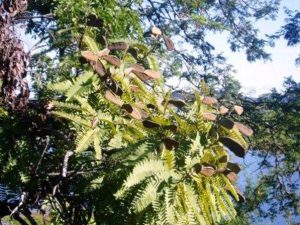
Brachystegia boehmii. Photo: Mark Hyde. Source: Flora of Zimbabwe
To the west of the Dyke, the country changes dramatically. The younger land surface here is rolling hills and about 100 to 150 meters lower than the east side. This drop in altitude, and the fact that this land is in the rain shadow of both the central watershed and the Great Dyke, causes the land to be warmer and drier on the west side. Acacias are more numerous. Brachystegia boehmii is more common. Distinctive Sterculia africana and Muwanga (Pericopsis angolensis) are seen.
Gold Dust Township lies at altitude of 1180m, on the west side of Masvikadei dam in hilly Brachystegia woodland. The most interesting feature of the woodland is that it is dominated by Brachystegia boehmii. I would estimate that the upper story comprised 90% to 95% Brachystegia boehmii. Only one rare Brachystegia spiciformis about 0.5 m high was seen! No Julbernardia globiflora were seen by me.
Why this dominance? I can offer two possible explanations. First soil characteristic. The soil was fairly shallow, fine grained light brown sandy loam derived from Lomagundi series meta-sediments.
Second soil water-logging. Quite a few wet spongy areas were seen on the hillsides indicating an impervious base rock. Msasas do not like to have wet feet in the dry season. The rocks on the east bank of the dam are granite. It would be interesting to follow up some time with a visit to the opposite shore where the climate will be the same, but the soils and vegetation will be different.
Some interesting observations during the day are noted. A tree with deeply fissured dark brown/black bark, and covered with small spherical spiked seed-cases that had defied early identification turned out to be a Mukwa (Pterocarpus angolensis) with galled fruit. A lone, normal seed was eventually identified. Two more Mukwa trees with a mix of galled and normal fruit were later seen.
A Commiphora mollis bled white latex profusely when it was stabbed. Judging by the pool of dried latex under a chopped off, but healed branch, the tree seemed unusually turgid. It probably did not like being watered in the dry season. In this tree a Yellow-fronted tinker-barbet defied a crowd of 11 observers and battled manfully to swallow the large red aril of one of the few ripe seeds.
By far the most interesting thing for me was a most unusual mistletoe occurrence. Sunbirds sip the nectar of the brightly coloured tubular flowers of the mistletoe, and are the main pollinators. Barbets and bulbuls and other birds love the ripe sticky fruit. Many of these seeds stick to the bird’s bills, and the birds then fly off to some nearby branch or tree, and wipe their bills till the seed no longer sticks to their bills, but to a branch.
Here the seed later geminates, and the mistletoe root then penetrates the branch for up to three meters, and parasitically feeds off the tree.
What was unusual about this mistletoe with pink flowers and grey green lanceolate leaves was that it was itself parasitized by mistletoe with light green rounded leaves and yellow flowers.
Maureen Silva-Jones noted that she had heard or seen on some documentary that on some mistletoes the leaves are cooled below ambient (presumably by transpiration). This was so on the round light green leaf, but not so on the other. A leaf that I carried away was still cooler than ambient about 10 minutes later, indicating that the process continued after removal. What purpose does this serve? Any answers or comment anyone?
-Bernard Beekes
BOOK REVIEW: SEED PLANTS OF SOUTHERN TROPICAL AFRICA: families and genera by O. A Leistner (2005).
This book is actually a supplement to an earlier book called Seed Plants of Southern Africa published in 2000 under the editorship of Dr. Leistner. The earlier book provided keys and descriptions of all families and genera occurring in South Africa, Botswana, Namibia, Swaziland and Lesotho.
The “new Leistner” extends this concept to cover 5 countries: Angola, Zambia, Zimbabwe, Malawi and Mozambique, all essentially in the tropical region just north of the area covered by the first book.
Why is this book useful? Firstly, a significant number of plant families have still to be covered by Flora Zambesiaca (e.g. Acanthaceae, Asclepiadaceae and Cyperaceae). Some of the genera within these families either do not occur or do not feature in the South African or East African floras and as a result, up to now, almost no information has been readily available about them.
(No doubt, the information would have been available somewhere in the literature but extracting it would not have been straightforward in Zimbabwe).
An example of such a genus is the forest floor acanthaceous genus of gregariously flowering species: Mimulopsis.
Now a key to the genera of Acanthaceae and a description of each genus is readily available.
The second reason why it is useful is that it takes into account many changes and new concepts in classification which again would not be easy to find out about from Zimbabwe.
One drawback is that where a genus in the new Leistner occurs in the first book, (this is of course true in many cases) the description is not repeated. This is a practical method of keeping down the size of the new Leistner, but obviously it has the drawback that both books are required to get the most out of them.
The new Leistner is a serious work: no pictures grace its pages – but for anyone with a general interest in the flora of Zimbabwe, the work is essential.
Two other features are also helpful. At the front there is a list of “Characteristics found only in a limited number of families”. For example, families containing species with no chlorophyll are listed. This concept is called ‘spot-characters’ by other authors and can be most useful in identifying plants by limiting the number of possibilities.
The book also includes an excellent glossary at the back.
The choice of genera and species is generally pretty accurate – although I did notice one or two omissions of aliens naturalised in Zimbabwe: e.g. Fraxinus and Ligustrum in Oleaceae, Macfadyena and (surprisingly) Jacaranda in the Bignoniaceae. However, this is not a major quibble and together the ‘two Leistners’ include most of the alien genera which occur in Zimbabwe.
Our warmest congratulations and thanks go to Dr Leistner for the excellent work he has done.
MARK HYDE CHAIRMAN


